theartsdesk in Lyon: Britten Fêted | reviews, news & interviews
theartsdesk in Lyon: Britten Fêted
theartsdesk in Lyon: Britten Fêted
A visionary production of The Turn of the Screw triumphs at the Opéra's three-work festival
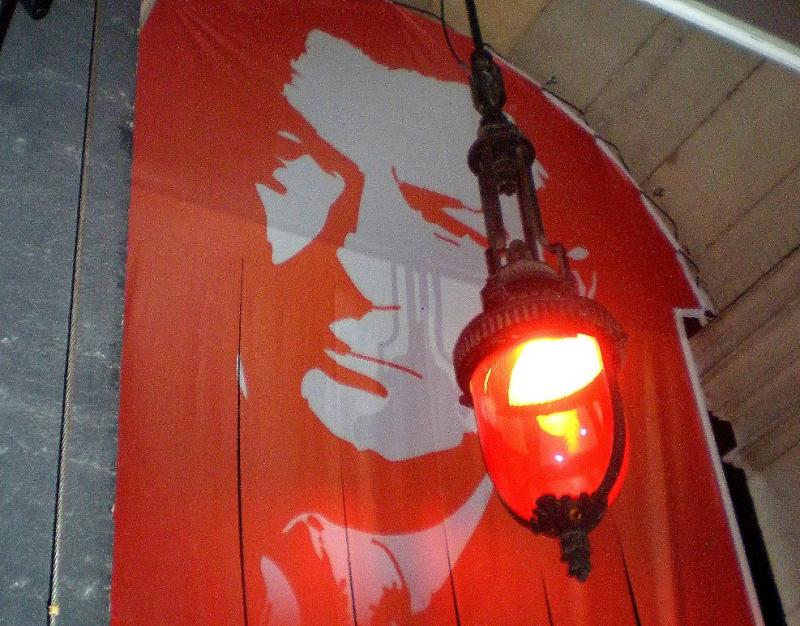
“Assez vu” (“seen enough”) is the first line of Benjamin Britten’s last Rimbaud setting in his electric song cycle Les Illuminations. Victor Hugo and Paul Verlaine had been the objects of his 14-year old attention in the Quatre Chansons françaises; later he made typically quirky arrangements of French folksongs. Les Illuminations has certainly been seen and heard enough in concert halls around Europe, even if you can never have too much of music as fresh as this.
You’d not be surprised to find Albert Herring, based on a Maupassant short story, a special favourite in regional France. The statistics for the capital certainly aren’t great, though. After early visits from Sadler’s Wells and the English Opera Group, Peter Grimes, the first tragic masterpiece of 1945, had to wait until 1981 to enter the Paris Opéra’s repertoire, Billy Budd until 1996; Death in Venice has still not been staged there. But its time in Lyon came five years ago, and the success of Yoshi Oida’s production led him to return for Grimes as part of a three-opera Britten Festival this year.
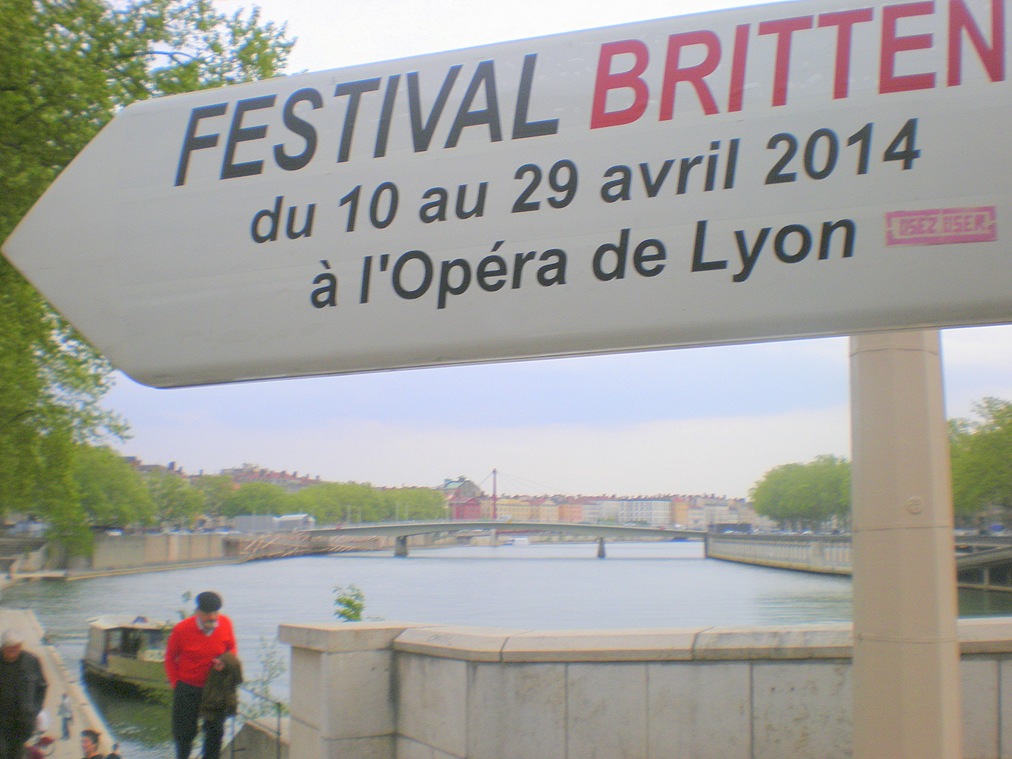 Eh bien, so it’s some time after the end of the exhaustive Britten centenary celebrations. Fine by me; Grimes, The Turn of the Screw and the shorter "church parable" Curlew River are among the 20th century’s greatest and most original operatic masterpieces. I hadn’t seen a major Screw in 2013 and was looking forward to encountering these three works one night after another, in the sort of festival planning I thought had stopped after the 100th birthday mark. Sadly, Eurostar meltdown due to a body on the tracks meant a five-hour delay at St Pancras, and a mad dash from Gare du Nord to Gare de Lyon for even the last train south took place long after Curlew River had meandered out of reach (I was offered an extended stay for a Bank Holiday Monday performance, but deadlines clamoured back home).
Eh bien, so it’s some time after the end of the exhaustive Britten centenary celebrations. Fine by me; Grimes, The Turn of the Screw and the shorter "church parable" Curlew River are among the 20th century’s greatest and most original operatic masterpieces. I hadn’t seen a major Screw in 2013 and was looking forward to encountering these three works one night after another, in the sort of festival planning I thought had stopped after the 100th birthday mark. Sadly, Eurostar meltdown due to a body on the tracks meant a five-hour delay at St Pancras, and a mad dash from Gare du Nord to Gare de Lyon for even the last train south took place long after Curlew River had meandered out of reach (I was offered an extended stay for a Bank Holiday Monday performance, but deadlines clamoured back home).
Yet it was still worth it to have arrived late on Easter Thursday night in this beautiful, inexhaustible town on the Rhône and the Saône (sign on the Saône pictured above) – a very long way from Britten’s North Sea - because at lunchtime on Good Friday, there was a Britten recital by two singers participating in the house’s Studio project, the equivalent of the Royal Opera's Jette Parker Young Artists Programme. Approaching the building for the first time this year, I took on board the striking but rather bizarre festival banners. The fashionable "Keep Calm" logo has been applied to our composer, though that’s the last thing you're usually able to do when you listen to Britten – the best you can hope for is to try and put yourself in a calm state to face the onslaught ahead. Odd, too, to have Lord B, who died in 1976, hailed as "one of the greatest composers of today" (banners pictured below). But let’s not be too literal about these things: he was going to be new to the very diverse and conspicuously youth-heavy audiences attending these reasonably-priced events.
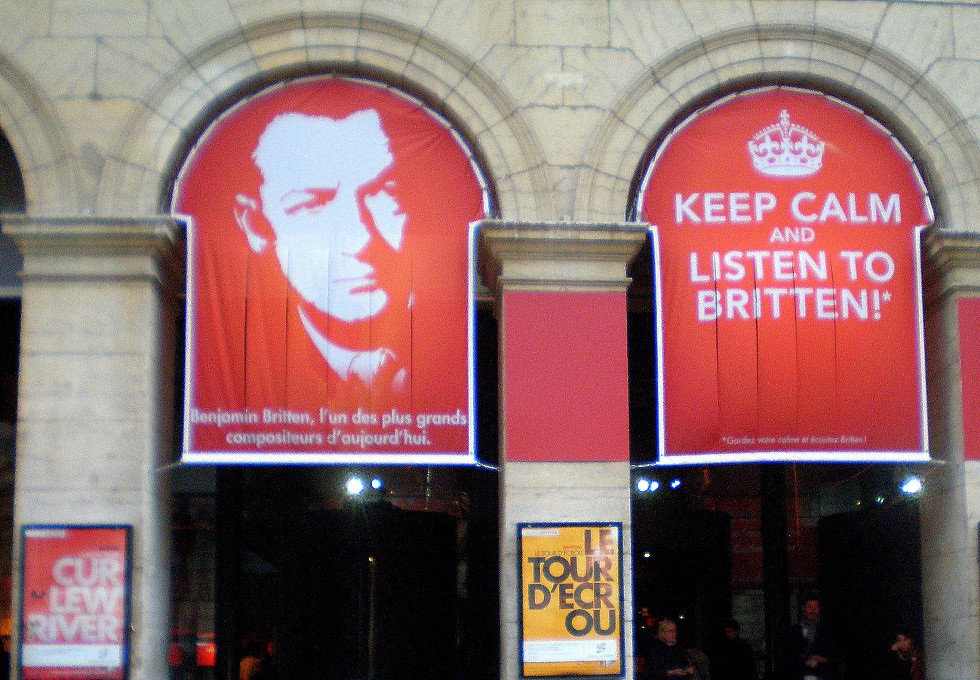 I knew Jean Nouvel’s all-enveloping red and black interior welded in to the 19th century façade - he'd left only the walls standing - from previous visits to see Idomeneo and Tristan und Isolde, and I’d been up to the dance studios behind the contemporary semi-cylindrical dome, their view over the city spectacular as you might expect. But I’d never discovered the AmphiOpéra downstairs, which the house is proud to have made a relaxed space. You could have munched your sandwiches, texted, talked; nobody did because the soprano and mezzo in question, Caroline McPhie and Laure Barras, presented their Britten (and Purcell ed. Britten) song-choices so beautifully and really made us listen.
I knew Jean Nouvel’s all-enveloping red and black interior welded in to the 19th century façade - he'd left only the walls standing - from previous visits to see Idomeneo and Tristan und Isolde, and I’d been up to the dance studios behind the contemporary semi-cylindrical dome, their view over the city spectacular as you might expect. But I’d never discovered the AmphiOpéra downstairs, which the house is proud to have made a relaxed space. You could have munched your sandwiches, texted, talked; nobody did because the soprano and mezzo in question, Caroline McPhie and Laure Barras, presented their Britten (and Purcell ed. Britten) song-choices so beautifully and really made us listen.
Both singers, cast as the "Nieces" in Peter Grimes, came across as polished artists with excellent techniques and perfectly-honed communication skills. The company’s Studio where they have been studying is clearly doing its job.I had a brief chat with its artistic director Jean-Paul Fouchécourt, whom I’d last seen in a green fat suit as Rameau’s Platée, and he confirmed the rigour: if the young performers seem to be growing in their promise, they get to stay for a second or third year, and I was to hear a successful graduate, Heather Newhouse, as the Governess in The Turn of the Screw that evening.
 Swiss-Canadian mezzo Barras (pictured with McPhie right) had her moments in two of the French folk songs, but some English vowels are tricky in song and the crucially delicious Auden texts for On This Island weren’t easily deciphered. To return the compliment, Leeds and London trained McPhie did a plausible job of mastering Pushkin in the original Russian of The Poet’s Echo. The absolute star was the pianist, Jamal Moqadem - as poised and as original a player as our own Joseph Middleton and Matt Fletcher, the young repetiteur I heard at Glyndebourne the other week who'd just been awarded the Kathleen Ferrier Accompanist's prize. Moqadem's conjuring of the nocturnal sounds in Britten’s supernatural setting of Pushkin’s “Lines written during a sleepless night” enhanced McPhie’s already audience-captivating sense of atmosphere.
Swiss-Canadian mezzo Barras (pictured with McPhie right) had her moments in two of the French folk songs, but some English vowels are tricky in song and the crucially delicious Auden texts for On This Island weren’t easily deciphered. To return the compliment, Leeds and London trained McPhie did a plausible job of mastering Pushkin in the original Russian of The Poet’s Echo. The absolute star was the pianist, Jamal Moqadem - as poised and as original a player as our own Joseph Middleton and Matt Fletcher, the young repetiteur I heard at Glyndebourne the other week who'd just been awarded the Kathleen Ferrier Accompanist's prize. Moqadem's conjuring of the nocturnal sounds in Britten’s supernatural setting of Pushkin’s “Lines written during a sleepless night” enhanced McPhie’s already audience-captivating sense of atmosphere.
Post-recital, we had time for a late lunch – events would circumscribe the chance of eating in one of Lyon’s famous traditional Bouchons, which keep very limited opening hours – and a checking-out of what else might be on of a more Easter-oriented nature. Not much that I could see, but we passed a blissful half hour in a classy but not expensive second-hand music shop on the old town’s Quai Romain Rolland. The charming shopkeeper was playing Rene Jacobs’s recording of Bach’s St Matthew Passion through a superb sound system with Werner Gura as a spellbinding Evangelist (I didn’t recognize the voice and was amazed).
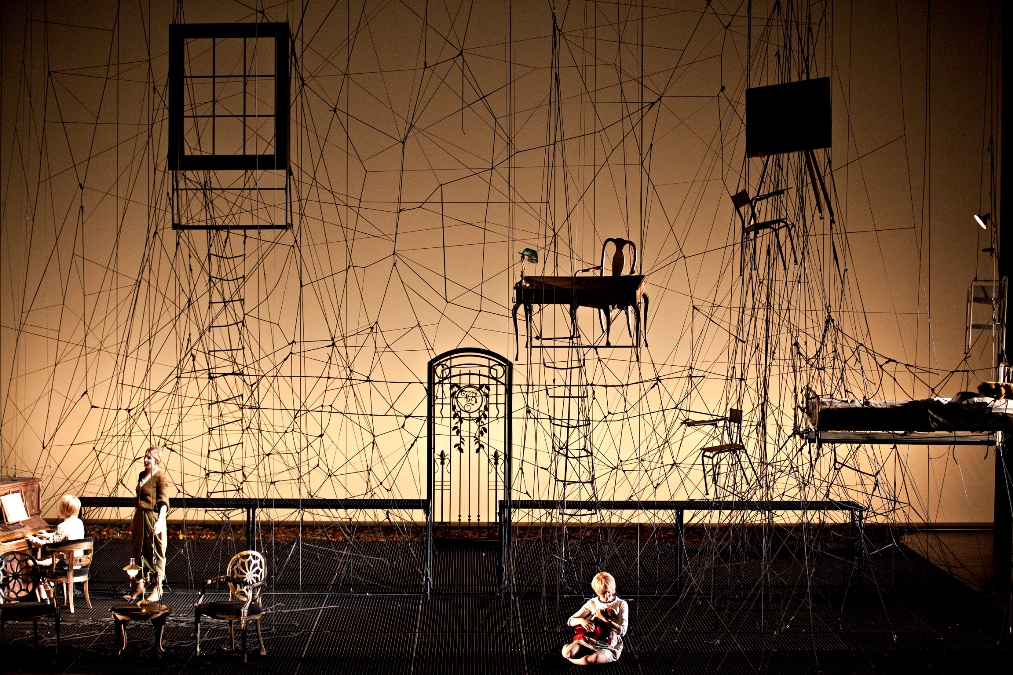
There was a darker and perhaps unredeemed sacrificial rite to witness on Good Friday night. Miles, one of two orphans watched over by an inexperienced and possibly dangerous young Governess, has to die in Henry James’s The Turn of the Screw, and we know that Britten – who told two friends he was raped by a master at school – had a special, horrified fascination with the boy’s possible corruption at the hands of a valet, deceased by the time the opera begins. Which is poisoned victim and which snake? Myfanwy Piper’s libretto tilts the action more in the direction of palpable ghosts, but the ambiguity can be kept and absolutely was in a visually stupendous production by Valentina Carrasco of La Fura dels Baus fame (I’d been giddied by their Lyon Tristan two years earlier).
An achingly beautiful and queasy video by Fabrice Coton of Woow Your Life threw up themes which were developed within Carlos Berga’s genius set. Taking a game mentioned in the opera, Carrasco used cat’s cradle as a kind of spider-web in which all the furniture onstage eventually became caught and suspended (pictured above in the first of three images by Jean-Louis Fernandez), to inscape the Governess’s increasingly loose grip on reality. Her fall was all the more poignant-scary in the hands of Newhouse, a pure, upright figure both vocally and physically to begin with. The children were blond in a Midwitch Cuckooish sort of way – we never know what they really think or feel – and convincing (none of the usual Infant Phenomenon disingenuousness from Loleh Pottier’s Flora).
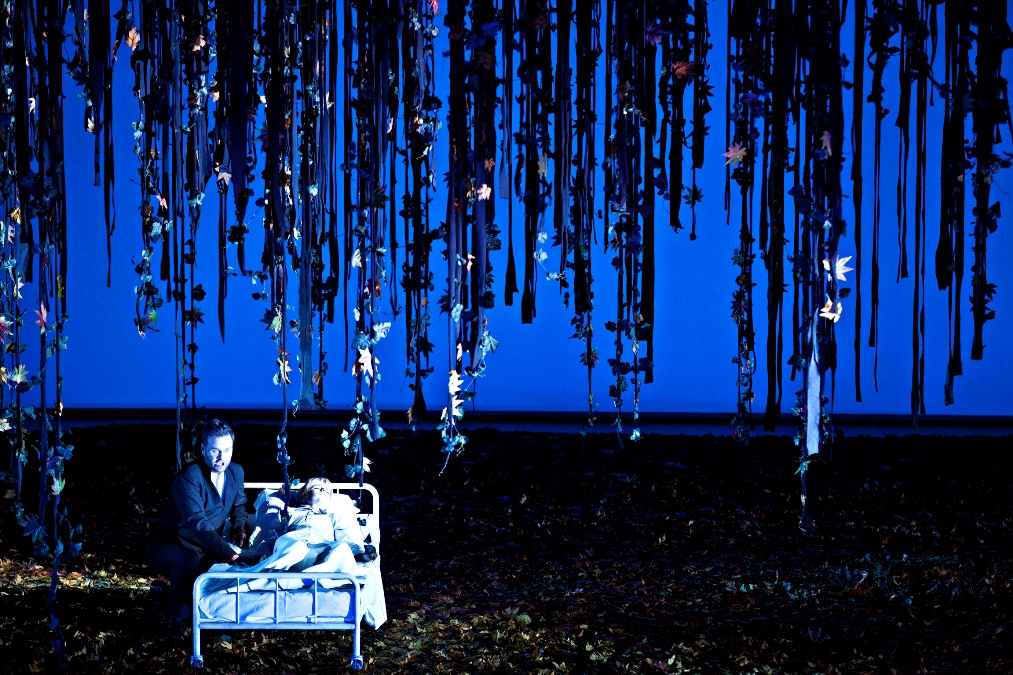 The tenor role of Quint has never, in my experience, sounded more seductive then in the subtle impersonation of Andrew Tortise (pictured left with Remo Ragonese's Miles), a singer of whom we’ve not seen enough in the UK beyond his riveting David in the Welsh National Opera Meistersinger and a scene-stealing appearance in the Royal Opera Gloriana as a clarion Spirit of the Masque. Miss Jessel, the almost equally fine Giselle Allen, was directed to play scary water-games (pictured below) and there was just a hint of perversity from Katharine Goeldner’s practically-clad housekeeper.
The tenor role of Quint has never, in my experience, sounded more seductive then in the subtle impersonation of Andrew Tortise (pictured left with Remo Ragonese's Miles), a singer of whom we’ve not seen enough in the UK beyond his riveting David in the Welsh National Opera Meistersinger and a scene-stealing appearance in the Royal Opera Gloriana as a clarion Spirit of the Masque. Miss Jessel, the almost equally fine Giselle Allen, was directed to play scary water-games (pictured below) and there was just a hint of perversity from Katharine Goeldner’s practically-clad housekeeper.
Yet the supreme hauntings were to be found in Lyon music director Kazushi Ono’s exquisite, often Debussyan handling of the 13 instrumentalists – viola and clarinet especially strong – and in Carrasco’s vision. This is the Turn of the Screw I’d most like to revisit on DVD; a shame it was not filmed. A company in the UK should snap it up, though it won't come cheap.
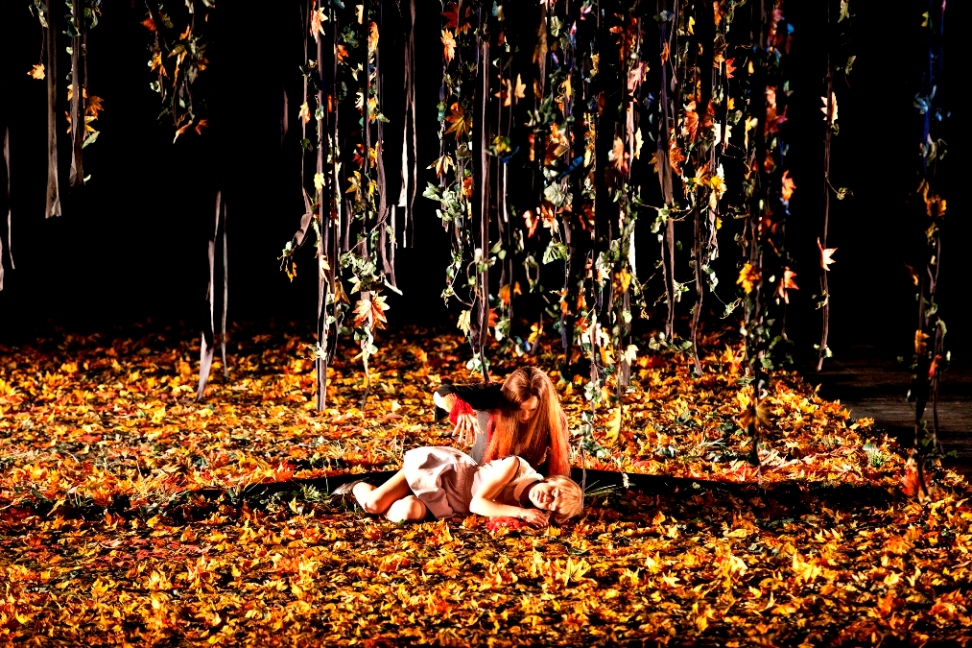 I wish I could make the same recommendation for Oida’s Peter Grimes the following night, a stark contrast to a sunny day’s wanderings through Lyon’s traboules or passageways and lunch al fresco at the Musées Gadagne. What I ought to note first is that the sheer genius of the score poleaxed me afresh and reduced me to teary shakiness through the whole of the second act – one of opera’s greatest – thanks especially to Ono’s lean but beautiful grip on the drama. Visually, unlike Carrasco’s tight realization, this was a case where less would have been infinitely more effective.
I wish I could make the same recommendation for Oida’s Peter Grimes the following night, a stark contrast to a sunny day’s wanderings through Lyon’s traboules or passageways and lunch al fresco at the Musées Gadagne. What I ought to note first is that the sheer genius of the score poleaxed me afresh and reduced me to teary shakiness through the whole of the second act – one of opera’s greatest – thanks especially to Ono’s lean but beautiful grip on the drama. Visually, unlike Carrasco’s tight realization, this was a case where less would have been infinitely more effective.
Tom Schenk’s painted backcloth was a work of art in its own right, inseparable from the lighting effects of Lutz Deppe which rendered it so various. A nearly bare stage would have kept the emphasis on the Opéra’s surprisingly big stage. Instead, Oida and his artistic collaborator Robert Kearley overloaded with unnecessary moving metal containers, significant only in giving different levels to an undifferentiated chorus. Then there was Grimes’s rusty boat, fitfully striking centre stage but an obstacle not easily manoeuvred (scene from the opera below by Jean Pierre Maurin).
The singing was equally varied. Alan Oke repeated his admirably unsympathetic Grimes from Aldeburgh beach, making you realize that while Stuart Skelton may have the encyclopedia of colours and lights in his voice for the role, he’s often too likable. Michaela Kaune’s Ellen Orford was best in quiet contemplation and turned in an artistic Embroidery Aria, but again singing Britten in what for the singer is a foreign language always seems to show – though nowhere near as glaringly as with Károly Szemerédy’s Swallow.
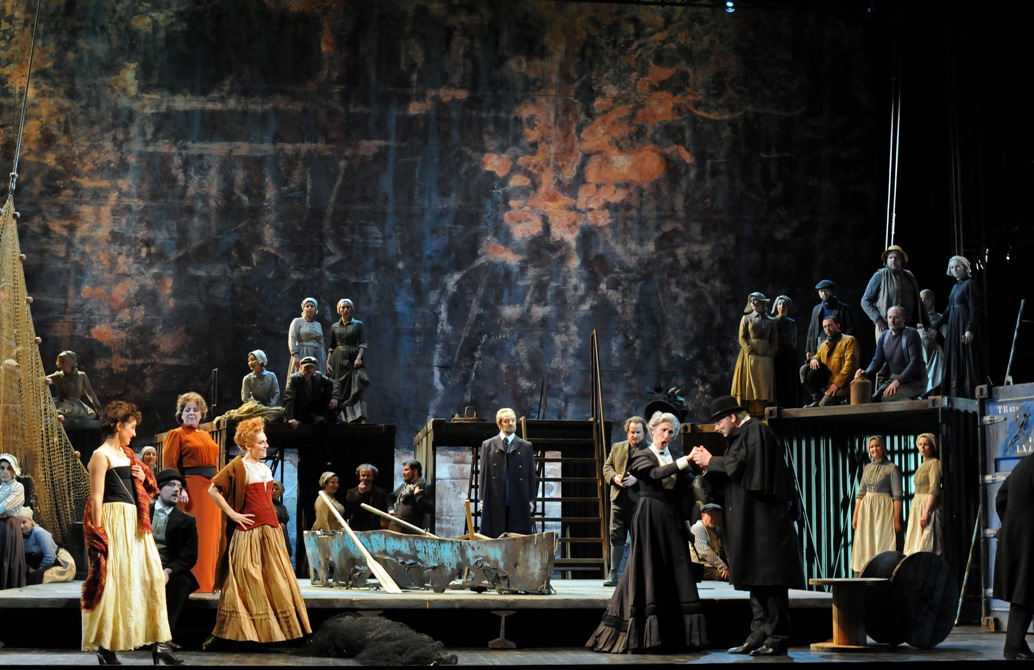 There were strong performances from Benedict Nelson’s handsomely sung Ned Keene and Andrew Foster-Williams’s forthright Balstrode, an overdone one from Rosalind Plowright as an unfathomable Mrs Sedley and far too stereotypical portraits of Auntie, or Tatie as the French know her, and her "Nieces" (blame the production), well as they undeniably sang.
There were strong performances from Benedict Nelson’s handsomely sung Ned Keene and Andrew Foster-Williams’s forthright Balstrode, an overdone one from Rosalind Plowright as an unfathomable Mrs Sedley and far too stereotypical portraits of Auntie, or Tatie as the French know her, and her "Nieces" (blame the production), well as they undeniably sang.
With paring-back and careful honing, this could have been better than the proverbial oeuf de curé. But at least the Lyonnais got to see a masterpiece, and seemed suitably stunned. Next season the rarities are Schreker’s decadent Die Gezeichneten and – at the Theatre de la Croix-Rousse up the hill – Boris Blacher’s Romeo und Julia. But Britten will be back in Lyon, you can be sure of that.
Explore topics
Share this article
The future of Arts Journalism
You can stop theartsdesk.com closing!
We urgently need financing to survive. Our fundraising drive has thus far raised £49,000 but we need to reach £100,000 or we will be forced to close. Please contribute here: https://gofund.me/c3f6033d
And if you can forward this information to anyone who might assist, we’d be grateful.

Subscribe to theartsdesk.com
Thank you for continuing to read our work on theartsdesk.com. For unlimited access to every article in its entirety, including our archive of more than 15,000 pieces, we're asking for £5 per month or £40 per year. We feel it's a very good deal, and hope you do too.
To take a subscription now simply click here.
And if you're looking for that extra gift for a friend or family member, why not treat them to a theartsdesk.com gift subscription?
more Opera
 Albert Herring, English National Opera review - a great comedy with depths fully realised
Britten’s delight was never made for the Coliseum, but it works on its first outing there
Albert Herring, English National Opera review - a great comedy with depths fully realised
Britten’s delight was never made for the Coliseum, but it works on its first outing there
 Carmen, English National Opera review - not quite dangerous
Hopes for Niamh O’Sullivan only partly fulfilled, though much good singing throughout
Carmen, English National Opera review - not quite dangerous
Hopes for Niamh O’Sullivan only partly fulfilled, though much good singing throughout
 Giustino, Linbury Theatre review - a stylish account of a slight opera
Gods, mortals and monsters do battle in Handel's charming drama
Giustino, Linbury Theatre review - a stylish account of a slight opera
Gods, mortals and monsters do battle in Handel's charming drama
 Susanna, Opera North review - hybrid staging of a Handel oratorio
Dance and signing complement outstanding singing in a story of virtue rewarded
Susanna, Opera North review - hybrid staging of a Handel oratorio
Dance and signing complement outstanding singing in a story of virtue rewarded
 Ariodante, Opéra Garnier, Paris review - a blast of Baroque beauty
A near-perfect night at the opera
Ariodante, Opéra Garnier, Paris review - a blast of Baroque beauty
A near-perfect night at the opera
 Cinderella/La Cenerentola, English National Opera review - the truth behind the tinsel
Appealing performances cut through hyperactive stagecraft
Cinderella/La Cenerentola, English National Opera review - the truth behind the tinsel
Appealing performances cut through hyperactive stagecraft
 Tosca, Royal Opera review - Ailyn Pérez steps in as the most vivid of divas
Jakub Hrůša’s multicoloured Puccini last night found a soprano to match
Tosca, Royal Opera review - Ailyn Pérez steps in as the most vivid of divas
Jakub Hrůša’s multicoloured Puccini last night found a soprano to match
 Tosca, Welsh National Opera review - a great company reduced to brilliance
The old warhorse made special by the basics
Tosca, Welsh National Opera review - a great company reduced to brilliance
The old warhorse made special by the basics
 BBC Proms: The Marriage of Figaro, Glyndebourne Festival review - merriment and menace
Strong Proms transfer for a robust and affecting show
BBC Proms: The Marriage of Figaro, Glyndebourne Festival review - merriment and menace
Strong Proms transfer for a robust and affecting show
 BBC Proms: Suor Angelica, LSO, Pappano review - earthly passion, heavenly grief
A Sister to remember blesses Puccini's convent tragedy
BBC Proms: Suor Angelica, LSO, Pappano review - earthly passion, heavenly grief
A Sister to remember blesses Puccini's convent tragedy
 Orpheus and Eurydice, Opera Queensland/SCO, Edinburgh International Festival 2025 review - dazzling, but distracting
Eye-popping acrobatics don’t always assist in Gluck’s quest for operatic truth
Orpheus and Eurydice, Opera Queensland/SCO, Edinburgh International Festival 2025 review - dazzling, but distracting
Eye-popping acrobatics don’t always assist in Gluck’s quest for operatic truth
 MARS, Irish National Opera review - silly space oddity with fun stretches
Cast, orchestra and production give Jennifer Walshe’s bold collage their all
MARS, Irish National Opera review - silly space oddity with fun stretches
Cast, orchestra and production give Jennifer Walshe’s bold collage their all

Add comment